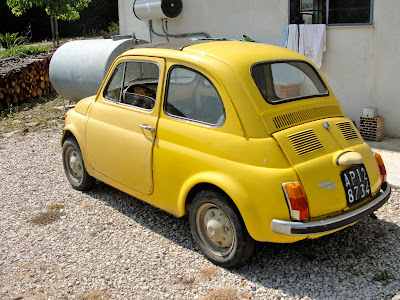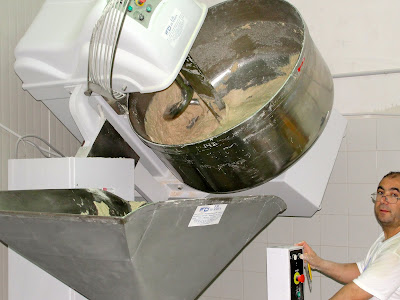



TOTA ITALIA IN TRIA CURRICULA DIVISA EST
We are often delighted and a bit amused with how laid back Italians are about matters of time. People just don’t seem to be as frantic as they are in the States. Things get done in Italy, more often than not done well and with pride...but not necessarily very quickly. I wonder if that is a function, in some small measure, of their Roman heritage. The Romans, you see, did not have minutes. None. Nada. Didn’t even have a word for the concept. Our word minute comes from the Latin minutus, ‘small’, as in minute, My-NOOT. The timekeepers that Romans had were just not practical for measuring such small increments of time.
One of my mentors at Chapel Hill wrote a very thought-provoking article about “Life without Minutes”. Can you imagine NOT being late for work, or for an appointment, or to pick up the kids at practice, or any of the dozen other minute-functional episodes we Americans confront in a typical day? The smallest time increment the Romans had was the half hour, so I suppose if you showed up an hour late, old Marcus Cato might be a bit peeved, but otherwise he’d just relax, have a little vinum, maybe hobnob with his chums about that young whippersnapper Gaius Julius, and be happy to see you when you appeared. As anal as I am about punctuality, that seems like heaven to me: a system that compels you to chill out and take life a little less seriously.
But there is one area where the Italians have a serious, chronic and urgent need for speed, and that is on the roads. To an American, the typical Italian driver drives like a pipistrello out of Inferno.
Which is ironic, since it is absolutely impossible to go fast through any but the most modern of Italian towns. The speed limits in towns are a clever little joke that we all wink and chuckle at. Most towns here date from the Middle Ages or before, and streets are often one-lane at best. The first time we were here we rented a little Ford Fiesta, the smallest of Ford’s European models at the time, because it was all we could afford. That was the smartest stupid decision I’ve ever made. Time after time I blessed Katie (Amy was five and she always christened our cars) for being able to maneuver through lanes where a larger car could not.
There was one instance when we were driving through Perugia, a beautiful Etruscan/Roman hill town in Umbria, trying to find the Centro, the center of the ancient city. God bless the Romans for the city grid plan; hill towns are gorgeous, but their tortuous streets are sometimes all but impenetrable. We finally just decided to keep going up, up, up until we couldn’t go up any more, on the theory that the best defensive position for the important stuff was at the top of that hill. We drove up a one-way street, winding along as the road became narrower and narrower, until we came to a stone portal on the other side of which was a sidewalk. What to do? The street was one way, and we didn’t have room to turn around if it had not been. Finally I got out of the car and walked over to the nearest shop, a sort of open-air barber shop as I recall, and asked in my bad Italian, “Signori, dov’è l’uscita?” (Sirs, where’s the exit?). Uproarious laughter (I kept half of Italy in stitches that trip) and all four men pointed simultaneously...to the sidewalk! It wasn’t a sidewalk at all, it was a street!
Well, we inched our way through, Amy giggling the whole time as her Mom moaned and peeked from behind the hands she had clasped over her eyes. And, sure enough, out we popped onto the perimeter of the piazza. My advice to you: if you ever rent a car in Italy with the intent of actually seeing anything but the autostrada, get a little one. Yeah, yeah, I know all that lore about the big ones being safer. Forget it. It doesn’t apply when you’re trying to stuff 20 pounds of machina into the 10-pound poke which is an Italian viale. Get the small one and remember that the most dangerous car in the world is a safe SUV with a loose nut behind the steering wheel.
So this time you may be sure we rented a small car, in this case a little Daewoo hatchback whom we’ve named Bianca. And she is bravissima, negotiating streets and highways with grace if not speed. The only serious issue she has is with the air conditioning. Bianca may be of Asiatic extraction, but she is a thoroughly assimilated Italian, and every time Sandy turns on the air she literally makes a coughing sound, and does so periodically thereafter just to let you know how disgusted she is. If we are climbing a major hill or the flank of a mountain, the air simply has to go off.
One thing that helps in Italian towns, and on the highways too, for that matter, is the Italian love of tondi (roundabouts), and I have to say that they work remarkably well because everyone is so cooperative. The key to using the tondo is to be assertive but not aggressive. Everyone expects you to poke your nose into the flow of traffic, they’re even anticipating it, and as often as not they’ll resent it if you don’t, because it interrupts the flow of traffic and slows everything down. In any case, we have seen exactly one semaphore on this trip to Italy, ONE! And where was it? Why, on a main highway outside Tavernanuova, at the crossroads with what appeared to be a pig trail. Evidently just one that was slated for removal but someone hasn’t gotten around to it. Please refer to remarks on time perceptions.
Maybe it’s because they know they’re going to encounter such delays in the towns that the Italians drive like hell on the highways. The speed limits on highways are a clever little joke that we all wink and chuckle at. Think nothing of seeing a Lancia tooling down the autostrada at 100 mph. If you drive like me, they will appear as a speck in your rear view mirror and by the time your mind has registered what you’re seeing, they’ll be a speck on the forward horizon.
On the state highways there is less scope for such frivolity, but most of the new state roads are built with extra wide lanes, and it’s just expected that people will pass constantly. The white line in the middle of the road? It's to mark the imaginary passing lane that we all know is there. See that Alfa tailgating you? Don’t be alarmed or angry, he’s just preparing to pass. And everybody cooperates! Cars being passed will courteously move as far to the right as they safely can to allow the car overtaking to scoot around as quickly as possible. If there is oncoming traffic—oh, yeah, they absolutely do pass in the face of oncoming traffic—cars coming from the opposite direction will scoot over in the other direction as well. If it looks like a particularly tight squeeze, cars on both ends will often brake to provide the extra three millimeters the passer needs to squeeze in at the last possible second.
I’m telling you, guys, it’s a thing of beauty if you can control your nerves. At this point the only passing situations that completely freak me out are the ones where a car is passing a semi and there’s another semi approaching. But I’ve seen it happen a half dozen times since we’ve been here!
So Sandy and I just habitually hug the line on the right side of the road and try to enjoy the show. And on the autostrada we generally stay in the right lane and poke along. No problems, right? Well...no. Some of the most hair-raising episodes I’ve had in Italy were in the right lane on the autostrada, tooling along at a respectable 90 kpo, 60 mph, when I drove up on a little Fiat Cinquecento (refer to previous blog), with a nice little Italian nonno going 25 mph on the interstate. It’s just not something an American expects, and twice I’ve almost sent Nonno flying.
But what to do about those pesky towns if you’re seriously hooked on speed? Why, get a moto (motorcycle) instead! Then you can weave in and out of traffic with reckless abandon, causing motorists to dodge you and seriously threatening pedestrians! On the highway, you can also dodge and weave, but at 80 mph! Oh, and by the way, that helmet strapped to the seat? Remember, it's a fashion accessory.
I’ll admit it, I enjoy the escapades of Italian drivers. But are they really so acrobatic that they can get away with such frolics? In a word, no. I’ve never heard an Italian admit it, but they are paying a grim toll for their addiction to the fast lane. For several years now Italy has had the highest rate of motor vehicle deaths of any European country, and the Poles are their only serious competition. The Italians are paying in tragedy for their need for speed, and, more tragically still, a disproportionate percent of the toll is their young people. With appalling regularity, life in the fast lane for Italians is leading to death in the fast lane.






















